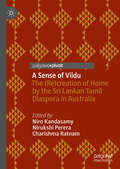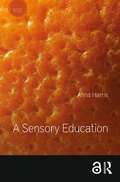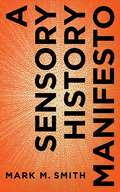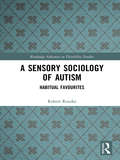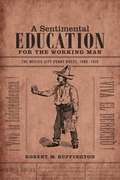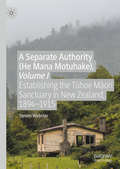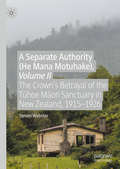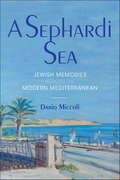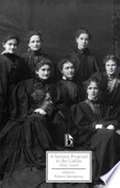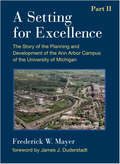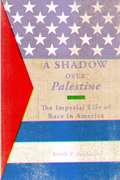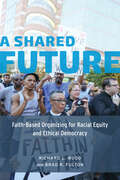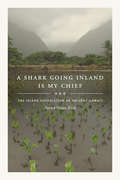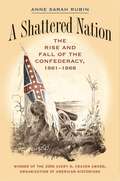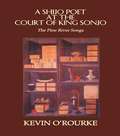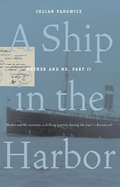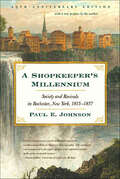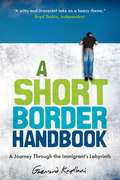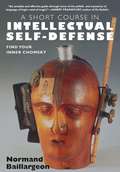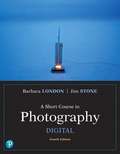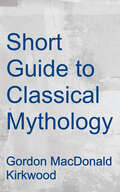- Table View
- List View
A Sense of Viidu: The (Re)creation of Home by the Sri Lankan Tamil Diaspora in Australia
by Niro Kandasamy Nirukshi Perera Charishma RatnamThis book is the first compilation of the experiences of the Sri Lankan Tamil diaspora in Australia. It explores the theme of home—from what is left behind to what is brought or (re)created in a new space—and all the complex processes that ensue as a result of leaving a land defined by conflict. The context of the book is unique since it focuses on the ten-year period since the Sri Lankan civil war ended in 2009. Although the war has officially come to an end, conflict continues in diverse and insidious forms, which we present from the point of view of those who have left Sri Lanka. The multidisciplinary nature of the book means that various aspects of Sri Lankan Tamil experiences are documented including trauma, violence, resettlement, political action, cultural and religious heritage, and intergenerational transmission. This book draws on qualitative methods from the fields of history, geography, sociology, sociolinguistics, psychology and psychiatry. Methodological enquiries range from oral histories and in-depth interviews to ethnography and self-reflexive accounts. To complement these academic chapters, creative contributions by prominent Sri Lankan artists in Australia seek to provide personalised and alternative interpretations on the theme of home. These include works from playwrights, novelists and community arts practitioners who also identify as human rights activists.
A Sense of the Future: Essays in Natural Philosophy
by Jacob BronowskiScientist, humanist, optimist, the late Jacob Bronowski in these essays explores the singularity of humankind, the essence of science, and the idea of a life force antecedent to nature.
A Sensory Education (Sensory Studies)
by Anna HarrisA Sensory Education takes a close look at how sensory awareness is learned and taught in expert and everyday settings around the world. Anna Harris shows that our sensing is not innate or acquired, but in fact evolves through learning that is shaped by social and material relations. The chapters feature diverse sources of sensory education, including field manuals, mannequins, cookbooks and flavour charts. The examples range from medical training and forest bathing to culinary and perfumery classes. Offering a valuable guide to the uncanny and taken-for-granted ways in which adults are trained to improve their senses, this book will be of interest to disciplines including anthropology and sociology as well as food studies and sensory studies.
A Sensory History Manifesto (Perspectives on Sensory History #4)
by Mark M. SmithA Sensory History Manifesto is a brief and timely meditation on the state of the field. It invites historians who are unfamiliar with sensory history to adopt some of its insights and practices, and it urges current practitioners to think in new ways about writing histories of the senses.Starting from the premise that the sensorium is a historical formation, Mark M. Smith traces the origins of historical work on the senses long before the emergence of the field now called "sensory history," interrogating, exploring, and in some cases recovering pioneering work on the topic. Smith argues that we are at an important moment in the writing of the history of the senses, and he explains the potential that this field holds for the study of history generally. In addition to highlighting the strengths of current work in sensory history, Smith also identifies some of its shortcomings. If sensory history provides historians of all persuasions, times, and places a useful and incisive way to write about the past, it also challenges current practitioners to think more carefully about the historicity of the senses and the desirability—even the urgency—of engaged and sustained debate among themselves. In this way, A Sensory History Manifesto invites scholars to think about how their field needs to evolve if the real interpretive dividends of sensory history are to be realized.Concise and convincing, A Sensory History Manifesto is a must-read for historians of all specializations.
A Sensory History Manifesto (Perspectives on Sensory History)
by Mark M. SmithA Sensory History Manifesto is a brief and timely meditation on the state of the field. It invites historians who are unfamiliar with sensory history to adopt some of its insights and practices, and it urges current practitioners to think in new ways about writing histories of the senses.Starting from the premise that the sensorium is a historical formation, Mark M. Smith traces the origins of historical work on the senses long before the emergence of the field now called “sensory history,” interrogating, exploring, and in some cases recovering pioneering work on the topic. Smith argues that we are at an important moment in the writing of the history of the senses, and he explains the potential that this field holds for the study of history generally. In addition to highlighting the strengths of current work in sensory history, Smith also identifies some of its shortcomings. If sensory history provides historians of all persuasions, times, and places a useful and incisive way to write about the past, it also challenges current practitioners to think more carefully about the historicity of the senses and the desirability—even the urgency—of engaged and sustained debate among themselves. In this way, A Sensory History Manifesto invites scholars to think about how their field needs to evolve if the real interpretive dividends of sensory history are to be realized.Concise and convincing, A Sensory History Manifesto is a must-read for historians of all specializations.
A Sensory Sociology of Autism: Habitual Favourites (Routledge Advances in Disability Studies)
by Robert RourkeThis innovative book places the sensory experiences of autistic individuals within a sociological framework. It instigates new discussions around sensory experience, autism and how disability and ability can be reconceived. Autism is commonly understood to involve social and communication difficulties. Less commented upon is the sensory challenges faced by those with autism. Sociology is no different, focusing on communication and neglecting the sensory dimensions of experience. Sensory experiences and relations are central to how we understand and navigate through the natural and social worlds, and mediate our interactions with other people, objects and spaces. In this book, the author explores how these processes are affected by the favourite activities of autistic people. With real-life case studies and cutting-edge research, this book will be useful to students, autistic people, advocates and carers, disability studies researchers and sociologies of disability and the senses.
A Sentimental Education for the Working Man: The Mexico City Penny Press, 1900-1910
by Robert M. BuffingtonIn A Sentimental Education for the Working Man Robert Buffington reconstructs the complex, shifting, and contradictory ideas about working-class masculinity in early twentieth-century Mexico City. He argues that from 1900 to 1910, the capital's satirical penny press provided working-class readers with alternative masculine scripts that were more realistic about their lives, more responsive to their concerns, and more representative of their culture than anything proposed by elite social reformers and Porfirian officials. The penny press shared elite concerns about the destructive vices of working-class men, and urged them to be devoted husbands, responsible citizens, and diligent workers; but it also used biting satire to recast negative portrayals of working-class masculinity and to overturn established social hierarchies. In this challenge to the "macho" stereotype of working-class Mexican men, Buffington shows how the penny press contributed to the formation of working-class consciousness, facilitated the imagining of a Mexican national community, and validated working-class men as modern citizens.
A Separate Authority (He Mana Motuhake), Volume I: Establishing the Tūhoe Māori Sanctuary in New Zealand, 1894–1915
by Steven WebsterThis book is an ethnohistorical reconstruction of the establishment in New Zealand of a rare case of Maori home-rule over their traditional domain, backed by a special statute and investigated by a Crown commission the majority of whom were Tūhoe leaders. However, by 1913 Tūhoe home-rule over this vast domain was being subverted by the Crown, which by 1926 had obtained three-quarters of their reserve. By the 1950s this vast area had become the rugged Urewera National Park, isolating over 200 small blocks retained by stubborn Tūhoe "non-sellers". After a century of resistance, in 2014 the Tūhoe finally regained statutory control over their ancestral domain and a detailed apology from the Crown.
A Separate Authority (He Mana Motuhake), Volume II: The Crown’s Betrayal of the Tūhoe Māori Sanctuary in New Zealand, 1915–1926
by Steven WebsterFollowing on from Volume I on the formation of the Urewera District Native Reserve, this monograph examines the period from 1908 to 1926, during which time the Crown subverted Tūhoe control of the UDNR, established a mere decade earlier. While Volume I described how the Tūhoe were able to deploy kin-based power to manipulate Crown power as well as confront one another, this volume describes ways in which the same ancestral descent groups closed ranks to survive nearly two decades of predatory Crown policies determined to dismantle their sanctuary. A relentless Crown campaign to purchase individual Tūhoe land shares ultimately resulted in a misleading Crown scheme to consolidate and relocate Tūhoe land shares, thereby freeing up land for the settlement of non- Tūhoe farmers. By the 1950s, over 200 small Tūhoe blocks were scattered throughout one of the largest National Parks in New Zealand. Although greatly weakened by these policies in terms of kinship solidarity as well as land and other resources, Tūhoe resistance continued until the return of the entire park in 2014—with unreserved apologies and promises of future support. In both volumes of A Separate Authority (He Mana Motuhake), Webster takes the stance of an ethnohistorian: he not only examines the various ways control over the Urewera District Native Reserve (UDNR) was negotiated, subverted or betrayed, and renegotiated during this time period, but also focuses on the role of Māori hapū, ancestral descent groups and their leaders, including the political economic influence of extensive marriage alliances between them. The ethnohistorical approach developed here may be useful to other studies of governance, indigenous resistance, and reform, whether in New Zealand or elsewhere.
A Sephardi Sea: Jewish Memories across the Modern Mediterranean (Sephardi and Mizrahi Studies)
by Dario MiccoliA Sephardi Sea tells the story of Jews from the southern shore of the Mediterranean who, between the late 1940s and the mid-1960s, migrated from their country of birth for Europe, Israel, and beyond. It is a story that explores their contrasting memories of and feelings for a Sephardi Jewish world in North Africa and Egypt that is lost forever but whose echoes many still hear. Surely, some of these Jewish migrants were already familiar with their new countries of residence because of colonial ties or of Zionism, and often spoke the language. Why, then, was the act of leaving so painful and why, more than fifty years afterward, is its memory still so tangible?Dario Miccoli examines how the memories of a bygone Sephardi Mediterranean world became preserved in three national contexts—Israel, France, and Italy—where the Jews of the Middle East and North Africa and their descendants migrated and nowadays live.A Sephardi Sea exploreshow practices of memory- and heritage-making—from the writing of novels and memoirs to the opening of museums and memorials, the activities of heritage associations and state-led celebrations—has filled an identity vacuum in the three countries and helps the Jews from North Africa and Egypt to define their Jewishness in Europe and Israel today but also reinforce their connection to a vanished world now remembered with nostalgia, affection, and sadness.
A Serious Proposal To The Ladies (Broadview Editions)
by Patricia Springborg Mary AstellMary Astell’s A Serious Proposal to the Ladies is one of the most important and neglected works advocating the establishment of women’s academies. Its reception was so controversial that Astell responded with a lengthy sequel, also in this volume. The cause of great notoriety, Astell’s Proposal was imitated by Defoe in his “An Academy for Women,” parodied in the Tatler, satirized on the stage, plagiarized by Bishop Berkeley, and later mocked by Gilbert and Sullivan in Princess Ida.
A Serious Sequence of Hidden Historical Accounts
by Stanley W. JohnsonThe record of black participation in the American military is primarily one of distinction. Black people have served in every significant military conflict from the Colonial period through the most recent United States engagements.
A Setting For Excellence, Part II: The Story of the Planning and Development of the Ann Arbor Campus of the University of Michigan
by Frederick W. MayerCampus planning is often a crucial underlying set of goals for university administrations, even if, over time, the mix of new and old buildings, changes in usage patterns and activities of students, and evolution of styles present challenges to a cohesive campus plan. In its two-hundred year history the University of Michigan has planned its campus in waves, from the earliest days of the iconic buildings around the Diag to the plans for the hospitals and the North Campus. This immensely informative and entertaining second volume in the history of the evolution of the campuses offers an absorbing narrative from the perspective of Fred Mayer, who served for more than three decades as the campus planner for the university during an important period of its growth during the late twentieth century. By tracing the development of the Ann Arbor campus from its early days to the present, within the context of the evolution of higher education in America, Mayer provides a strong argument for the importance of rigorous and enlightened campus planning as a critical element of the learning environment of the university. His comprehensive history of campus planning, illustrated with photos, maps, and diagrams from Michigan’s history, is an outstanding contribution to the university’s history as it approaches its bicentennial.
A Seventh Man: Migrant Workers in Europe
by John BergerA description of the exploitation of migrant workers in Europe during the mid 20th century.
A Shadow over Palestine: The Imperial Life of Race in America
by Keith P. FeldmanWinner, Best Book in Humanities and Cultural Studies (Literary Studies), Association for Asian American Studies Upon signing the first U.S. arms agreement with Israel in 1962, John F. Kennedy assured Golda Meir that the United States had &“a special relationship with Israel in the Middle East,&” comparable only to that of the United States with Britain. After more than five decades such a statement might seem incontrovertible—and yet its meaning has been fiercely contested from the start. A Shadow over Palestine brings a new, deeply informed, and transnational perspective to the decades and the cultural forces that have shaped sharply differing ideas of Israel&’s standing with the United States—right up to the violent divisions of today. Focusing on the period from 1960 to 1985, author Keith P. Feldman reveals the centrality of Israel and Palestine in postwar U.S. imperial culture. Some representations of the region were used to manufacture &“commonsense&” racial ideologies underwriting the conviction that liberal democracy must coexist with racialized conditions of segregation, border policing, poverty, and the repression of dissent. Others animated vital critiques of these conditions, often forging robust if historically obscured border-crossing alternatives. In this rich cultural history of the period, Feldman deftly analyzes how artists, intellectuals, and organizations—from the United Nations, the Black Panther Party, and the Association of Arab American University Graduates to James Baldwin, Daniel Patrick Moynihan, Edward Said, and June Jordan—linked the unfulfilled promise of liberal democracy in the United States with the perpetuation of settler democracy in Israel and the possibility of Palestine&’s decolonization.In one of his last essays, published in 2003, Edward Said wrote, &“In America, Palestine and Israel are regarded as local, not foreign policy, matters.&” A Shadow over Palestine maps this jagged terrain on which this came to be, amid a wealth of robust alternatives, and the undeterred violence at home and abroad unleashed as a result of this special relationship.
A Shared Future: Faith-Based Organizing for Racial Equity and Ethical Democracy
by Richard L. Wood Brad R. FultonFaith-based community organizers have spent decades working for greater equality in American society, and more recently have become significant players in shaping health care, finance, and immigration reform at the highest levels of government. In A Shared Future, Richard L. Wood and Brad R. Fulton draw on a new national study of community organizing coalitions and in-depth interviews of key leaders in this field to show how faith-based organizing is creatively navigating the competing aspirations of America's universalist and multiculturalist democratic ideals, even as it confronts three demons bedeviling American politics: economic inequality, federal policy paralysis, and racial inequity. With a broad view of the entire field and a distinct empirical focus on the PICO National Network, Wood and Fulton's analysis illuminates the tensions, struggles, and deep rewards that come with pursuing racial equity within a social change organization and in society. Ultimately, A Shared Future offers a vision for how we might build a future that embodies the ethical democracy of the best American dreams.
A Shark Going Inland Is My Chief: The Island Civilization of Ancient Hawai'i
by Patrick Vinton KirchTracing the origins of the Hawaiians and other Polynesians back to the shores of the South China Sea, archaeologist Patrick Vinton Kirch follows their voyages of discovery across the Pacific in this fascinating history of Hawaiian culture from about one thousand years ago. Combining more than four decades of his own research with Native Hawaiian oral traditions and the evidence of archaeology, Kirch puts a human face on the gradual rise to power of the Hawaiian god-kings, who by the late eighteenth century were locked in a series of wars for ultimate control of the entire archipelago. This lively, accessible chronicle works back from Captain James Cook's encounter with the pristine kingdom in 1778, when the British explorers encountered an island civilization governed by rulers who could not be gazed upon by common people. Interweaving anecdotes from his own widespread travel and extensive archaeological investigations into the broader historical narrative, Kirch shows how the early Polynesian settlers of Hawai'i adapted to this new island landscape and created highly productive agricultural systems.
A Shattered Nation
by Anne Sarah RubinHistorians often assert that Confederate nationalism had its origins in pre-Civil War sectional conflict with the North, reached its apex at the start of the war, and then dropped off quickly after the end of hostilities. Anne Sarah Rubin argues instead that white Southerners did not actually begin to formulate a national identity until it became evident that the Confederacy was destined to fight a lengthy war against the Union. She also demonstrates that an attachment to a symbolic or sentimental Confederacy existed independent of the political Confederacy and was therefore able to persist well after the collapse of the Confederate state. White Southerners redefined symbols and figures of the failed state as emotional touchstones and political rallying points in the struggle to retain local (and racial) control, even as former Confederates took the loyalty oath and applied for pardons in droves.Exploring the creation, maintenance, and transformation of Confederate identity during the tumultuous years of the Civil War and Reconstruction, Rubin sheds new light on the ways in which Confederates felt connected to their national creation and provides a provocative example of what happens when a nation disintegrates and leaves its people behind to forge a new identity.Historians often assert that Confederate nationalism had its origins in pre-Civil War sectional conflict with the North, reached its apex at the start of the war, and then dropped off quickly after the end of hostilities. Anne Sarah Rubin argues instead that white Southerners did not actually begin to formulate a national identity until it became evident that the Confederacy was destined to fight a lengthy war against the Union. She also demonstrates that an attachment to a symbolic or sentimental Confederacy existed independent of the political Confederacy and was therefore able to persist well after the collapse of the Confederate state. White Southerners redefined symbols and figures of the failed state as emotional touchstones and political rallying points in the struggle to retain local (and racial) control, Rubin argues, even as former Confederates took the loyalty oath and applied for pardons in droves.-->
A Shijo Poet at the Court of King Sonjo: The Pine River Songs
by Kevin O'RourkeA Shijo Poet at the Court of K•ing Somo: The Pine River Songs is translation of Songgang kasa, Chong Ch'ol's (1536-1593) famous collection of-Korean songs. The translations are by Kevin O'Rourke, one of the foremost translators of Korean literature into English in the world today. Professor O'Rourke includes in the volume a biographical sketch of the Choson dynasty poet-official and a crifica1 analysis of his work. These essays provide a fascinating background to the life and work of this enigmatic man. Royal Inspector (governor of a province, personal secretary to the king, second minister general of the army - these are some of the positions held by Chong Ch'ol during a career that was punctuated by periods of voluntary retirement, dismissal and exile. He was by nature a brilliant but rather stubborn man. Loved by his friends, hated py his enemies, his life was marked by continuous controversy. Korean commentators traditionally regard Chong Ch'ol as the greatest exponent of the essay-poem genre called kasa- his kasa were immensely popular in his own lifetime - and they consistently place him among_ the great shijo poets. Readers of A Shijo Poet at the Court of King Sonjo: The Pine River Songs will be struck by the literary quality of the shijo, which are without peer in the history of the genre, and by the urbanity and cultiva1ion of the Kasa poems. These poems come alive for the first time in English versions that stand on their own as English poems.
A Ship in the Harbor, Mother and Me: Book II
by Julian Padowicz"Mother and Me recounts a chilling journey during the war." A story of escape from the Nazis during WWII continues.
A Shopkeeper's Millennium: Society and Revivals in Rochester, New York, 1815–1837
by Paul E. JohnsonA quarter-century after its first publication, A Shopkeeper's Millennium remains a landmark work--brilliant both as a new interpretation of the intimate connections among politics, economy, and religion during the Second Great Awakening, and as a surprising portrait of a rapidly growing frontier city. The religious revival that transformed America in the 1820s, making it the most militantly Protestant nation on earth and spawning reform movements dedicated to temperance and to the abolition of slavery, had an especially powerful effect in Rochester, New York. Paul E. Johnson explores the reasons for the revival's spectacular success there, suggesting important links between its moral accounting and the city's new industrial world. In a new preface, he reassesses his evidence and his conclusions in this major work.
A Short Border Handbook: A Journey Through the Immigrant's Labyrinth
by Anne-Marie Stanton-Ife Gazmend KapllaniAn exhilarating and darkly comical exploration of migration and borders from an Albanian who grew up in Hoxha's madhouse, longing to cross to Greece, only to find another seam of absurdities and disappointments on his eventual arrival.After spending his childhood in Albania, and fantasizing about life across the border, Gazmend Kapllani escapes to Greece--only to get banged up in a detention center. As he and his fellow immigrants try to find jobs, they begin to plan their future lives in Greece, imagining success that is always beyond their grasp. The sheer absurdity of both their plans and their new lives is overwhelming. Both ironic and emotional, Kapllani interweaves the story of his experience with meditations upon "border syndrome"--a mental state, as much as a geographical experience--to create a brilliantly observed, amusing, and perceptive debut. And a timely one at that, given that immigration is again at the forefront of politics both in the US and Europe.
A Short Course in Intellectual Self Defense: Find Your Inner Chomsky
by Andrea Schmidt Normand Baillargeon CharbWhat is the relationship between democracy and critical thinking? What must a citizen in a democracy know to make the word democracy meaningful? In A Short Course in Intellectual Self-Defense, historian and educator Normand Baillargeon provides readers with the tools to see through the spin and jargon of everyday politics and news reporting in order to decide for themselves what is at stake and how to ask the necessary questions to protect themselves from the manipulations of the government and the media. Whether the issue be the call to what we're told will be a bloodless war, the "debate" around Intelligent Design, or the meaning of a military expenditure, Baillargeon teaches readers to evaluate information and sort fact from official and media spin.
A Short Course in Photography: Digital
by Barbara London Jim StoneExplores basic techniques in digital photography <P><P>Modeled after the widely used A Short Course in Photography: Film and Darkroom , the 4th Edition of A Short Course in <P><P>Photography: Digital presents the basic techniques of photography in its contemporary, digital form. This brief volume emphasizes the most up-to-date learning techniques, allowing readers to keep up with modern technology and explore artistic choices via in-depth discussion of photographic techniques. <P><P>In addition to covering the basics of digital photography, this title also covers the impact of computers and software on the art of photography. The 4th Edition includes new contemporary photographs by great artists, information on the latest digital camera technology and software, and integration of workflow applications.
A Short Guide to Classical Mythology
by G. M. KirkwoodA Short Guide to Classical Mythology is a concise, user-friendly, quick reference for general readers, students and teachers. Kirkwood's treatment of the characters, settings and stories of ancient mythology emphasizes their importance in Western literature. The entries are ordered alphabetically, vary in length according to their significance and include bold and italic typefaces to draw the reader's attention to important terms and cross references. Kirkwood's text provides a user-friendly, quick reference guide for teachers, students, and general readers. It is an excellent, interdisciplinary resource beneficial in the study of classics, literature, and history.
